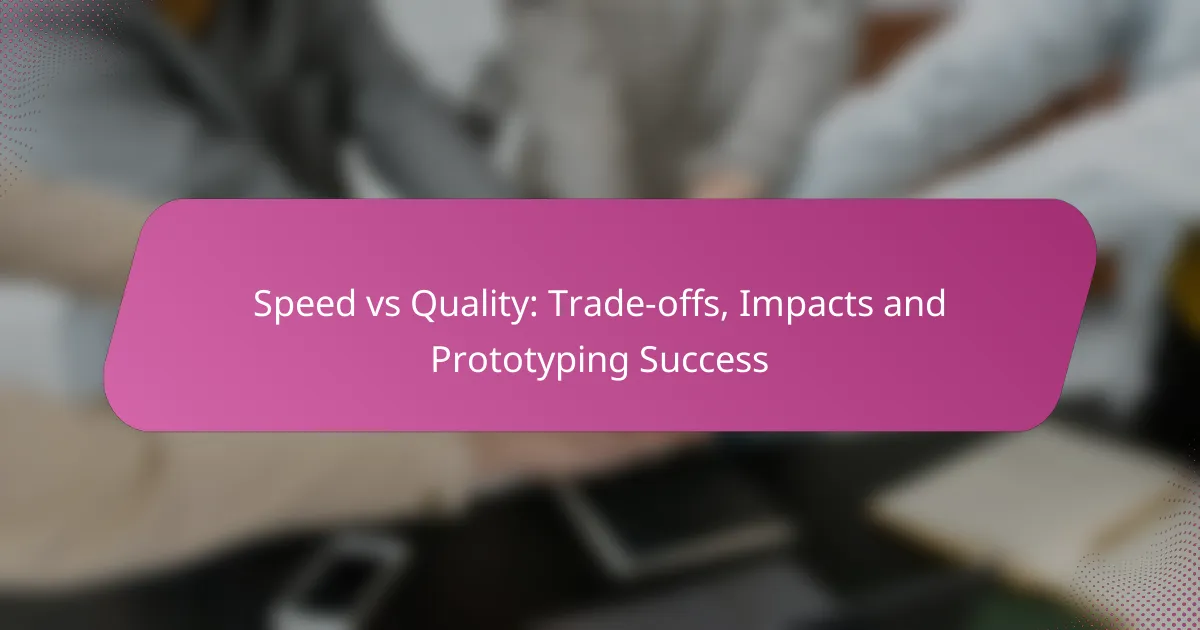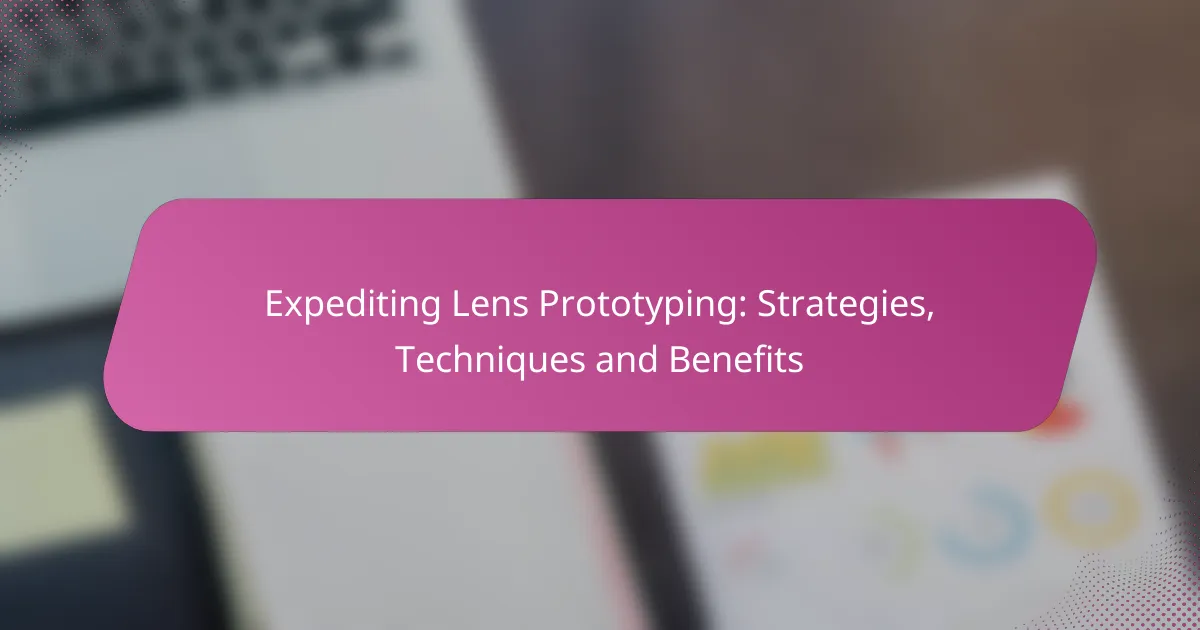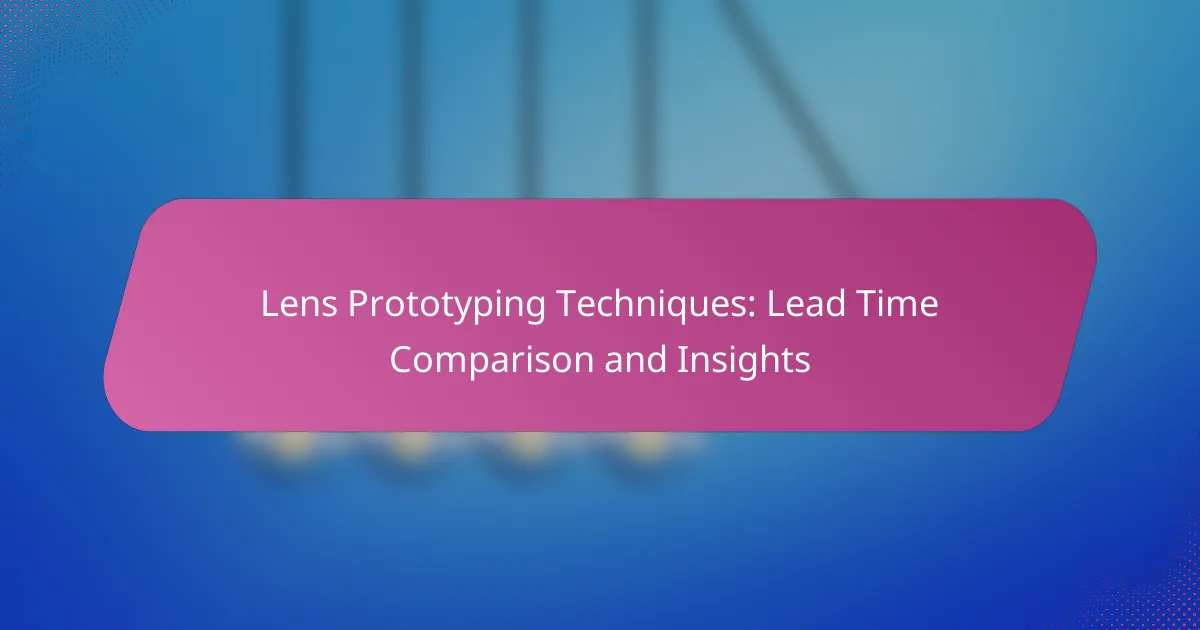In the realm of prototyping, the balance between speed and quality is crucial for achieving project success. While prioritizing speed can accelerate development, it often comes with risks such as technical debt and user dissatisfaction. Conversely, a focus on quality may delay delivery but can enhance long-term reliability and performance. Understanding these trade-offs is essential for making informed decisions that align with project goals.

How to balance speed and quality in prototyping?
Balancing speed and quality in prototyping involves making strategic decisions to optimize both aspects without compromising the overall project goals. Prioritizing essential features and employing efficient methodologies can help achieve this equilibrium.
Agile methodologies
Agile methodologies focus on iterative development, allowing teams to adapt quickly to changes while maintaining high quality. By breaking projects into smaller increments, teams can deliver functional prototypes faster and incorporate feedback more effectively.
Common Agile frameworks include Scrum and Kanban, which emphasize collaboration and flexibility. These approaches encourage regular check-ins and adjustments, ensuring that quality is not sacrificed for speed.
Rapid prototyping techniques
Rapid prototyping techniques enable teams to create quick and cost-effective models of their ideas. Techniques such as 3D printing, wireframing, and mockups allow for immediate visualization and testing of concepts.
Using tools like Figma or Sketch can streamline the design process, making it easier to iterate and refine prototypes based on user feedback. This approach helps identify potential issues early, reducing the need for extensive revisions later.
Iterative feedback loops
Implementing iterative feedback loops is crucial for balancing speed and quality in prototyping. By regularly gathering input from stakeholders and users, teams can make informed adjustments to their designs.
Establishing a schedule for feedback sessions, such as bi-weekly reviews, can ensure that the project stays on track while allowing for necessary changes. This practice minimizes the risk of significant rework and enhances the final product’s quality.
Cross-functional teams
Cross-functional teams bring together diverse skill sets, enhancing the prototyping process. By including members from design, development, and marketing, teams can address various aspects of a project simultaneously.
This collaboration fosters a holistic approach to prototyping, ensuring that speed does not compromise quality. Regular communication among team members can lead to quicker problem-solving and more innovative solutions.
Design sprints
Design sprints are intensive, time-constrained sessions aimed at solving specific design challenges. Typically lasting five days, these sprints focus on rapid ideation, prototyping, and testing, allowing teams to validate concepts quickly.
By concentrating efforts within a short timeframe, teams can produce high-quality prototypes while maintaining a fast pace. This method encourages experimentation and can lead to valuable insights that inform future development efforts.

What are the impacts of prioritizing speed over quality?
Prioritizing speed over quality can lead to significant negative consequences, including technical debt, user dissatisfaction, and increased long-term costs. These impacts can undermine the initial benefits of rapid development and create challenges for future projects.
Increased technical debt
When speed is prioritized, teams often take shortcuts that result in technical debt. This can manifest as poorly written code, lack of documentation, or inadequate testing, which may seem acceptable in the short term but complicates future development. Over time, this debt accumulates, making it harder to implement new features or fix existing issues.
To manage technical debt, teams should regularly assess their code quality and allocate time for refactoring. A good rule of thumb is to dedicate a portion of each sprint to addressing technical debt, ensuring it does not become overwhelming.
Reduced user satisfaction
Speed-focused development can lead to products that do not meet user expectations, resulting in reduced satisfaction. Users may encounter bugs, poor performance, or a lack of essential features, which can drive them to competitors. This dissatisfaction can be particularly damaging in markets where user experience is critical.
To enhance user satisfaction, it is vital to gather feedback early and often. Implementing user testing and incorporating feedback into the development process can help ensure that the final product aligns with user needs and expectations.
Higher long-term costs
While prioritizing speed may save time and resources initially, it often leads to higher long-term costs. Fixing issues that arise from rushed development can require significant investment in both time and money. Additionally, the potential loss of customers due to dissatisfaction can further impact revenue.
To mitigate these costs, organizations should consider the trade-offs between speed and quality. Investing in thorough testing and quality assurance upfront can prevent costly fixes down the line, ultimately leading to a more sustainable development process.

What are the trade-offs between speed and quality?
The trade-offs between speed and quality involve balancing the urgency of delivering a product against the need for reliability and performance. Prioritizing speed can lead to compromises in quality, while focusing on quality may delay time-to-market.
Time-to-market vs. product reliability
Time-to-market refers to how quickly a product can be launched, while product reliability indicates how well it performs over time without failure. Companies often face pressure to release products quickly, which can result in less thorough testing and potential issues post-launch.
For instance, a software application may be rushed to meet a deadline, leading to bugs that affect user satisfaction. A good practice is to establish a minimum viable product (MVP) that balances essential features with adequate testing to ensure reliability.
Cost efficiency vs. user experience
Cost efficiency involves minimizing expenses while developing a product, whereas user experience focuses on how enjoyable and effective the product is for its users. Cutting costs may lead to lower quality materials or insufficient user testing, which can degrade the overall experience.
For example, a company might choose cheaper components for a gadget to save money, but this could result in a product that fails to meet user expectations. Prioritize user feedback during development to ensure that cost-saving measures do not compromise the experience.
Flexibility vs. stability
Flexibility allows a team to adapt quickly to changes, while stability ensures a consistent and reliable product. Striking the right balance is crucial; too much flexibility can lead to a lack of direction and quality, while excessive stability may hinder innovation and responsiveness.
For instance, an agile development team may frequently adjust features based on user feedback, but if changes are made too often, it can confuse users and lead to a fragmented product. Establish a clear framework for making changes while maintaining core functionalities to achieve both flexibility and stability.

What criteria should be used for decision-making?
Effective decision-making in projects requires clear criteria that balance speed and quality. Key factors include project scope, target audience needs, and market competition analysis, which help guide choices that align with overall objectives.
Project scope and goals
Defining the project scope and goals is essential for determining the trade-offs between speed and quality. Establish clear objectives, such as deliverables, timelines, and budget constraints, to ensure all stakeholders understand the project’s direction.
For example, if a project aims to launch a minimum viable product (MVP) quickly, the scope may need to be narrowed to essential features only. This approach allows for faster iterations while still meeting core user needs.
Target audience needs
Understanding the target audience is crucial for making informed decisions about speed versus quality. Conduct user research to identify their preferences, pain points, and expectations, which will inform how much emphasis to place on quality versus rapid delivery.
For instance, if the audience values performance and reliability, investing more time in quality assurance may be necessary. Conversely, if they prioritize speed, a quicker release with planned updates might be more appropriate.
Market competition analysis
Analyzing the competitive landscape helps determine the urgency of delivering a product. Assess competitors’ offerings, market trends, and customer feedback to gauge where your project stands and how quickly it needs to adapt.
For example, if competitors are rapidly releasing features, it may be vital to prioritize speed to maintain market relevance. However, if the market is stable, focusing on quality improvements can provide a competitive edge in the long run.

How to measure success in prototyping?
Success in prototyping can be measured through a combination of user feedback, time efficiency, and quality assurance. These metrics help determine how well a prototype meets user needs, how quickly it can be developed, and how reliably it performs.
User feedback metrics
User feedback metrics are essential for understanding how well a prototype resonates with its intended audience. Common methods include surveys, usability tests, and interviews, which can provide qualitative insights and quantitative scores on user satisfaction.
Key metrics to consider include Net Promoter Score (NPS), task completion rates, and user satisfaction ratings. Aim for a balance between qualitative feedback and quantitative data to get a comprehensive view of user experience.
Time efficiency metrics
Time efficiency metrics focus on how quickly a prototype can be developed and iterated. Track the total time spent on each phase of prototyping, including design, testing, and revisions, to identify bottlenecks.
Common time efficiency indicators include cycle time, which measures the duration from concept to prototype, and lead time, which assesses the time from idea inception to user testing. Aim for shorter cycle times to enhance responsiveness to user needs.
Quality assurance benchmarks
Quality assurance benchmarks ensure that the prototype meets predefined standards and functions as intended. This includes testing for usability, functionality, and performance under various conditions.
Establish criteria such as defect rates, compliance with design specifications, and performance metrics like load times. Regularly review these benchmarks to maintain high quality and make necessary adjustments based on user feedback and testing results.



